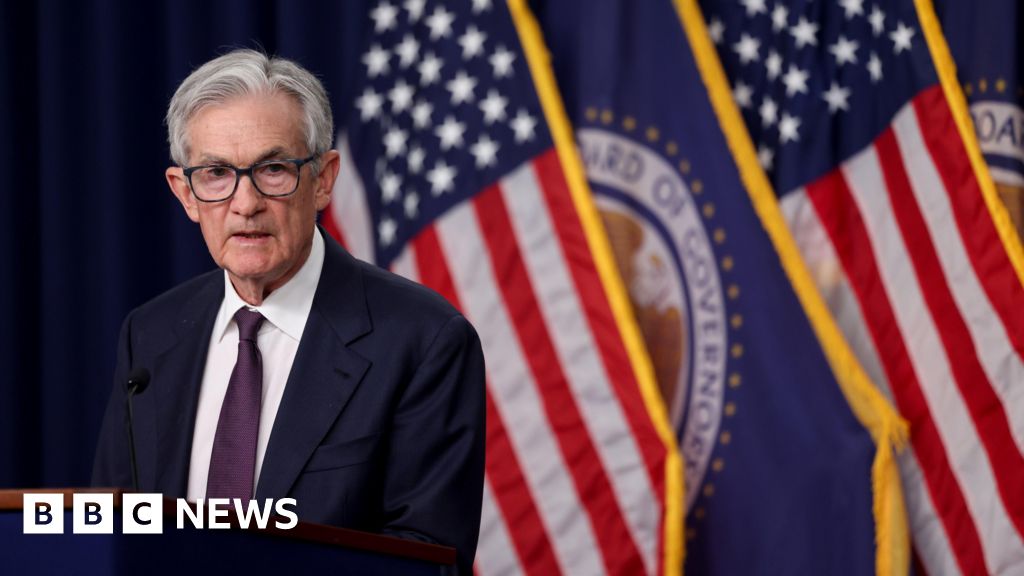People and businesses in the US have faced a whirlwind of policy change in recent months. But one thing has remained fixed: borrowing costs set by the US central bank. The Federal Reserve stuck with that strategy on Wednesday, leaving its key interest rate unchanged, even as officials' expectations for the economy worsened. The decision marked the fourth in a row without action, keeping the bank's influential lending rate hovering around 4.3%, where it has stood since December. That came despite forecasts from policymakers suggesting they expect slower growth, higher unemployment and faster inflation than they did just a few months ago. Typically, the Fed lowers borrowing costs if it believes the economy is struggling and raises them if prices start to rise too quickly. Inflation, the pace of price increases, remains above the Fed's 2% target, coming in at 2.4% in May. President Donald Trump has repeatedly called on the Fed to cut interest rates, arguing, in part, that the problem has faded. But Fed officials, who are empowered to make policy independent of the White House, have said they will make decisions based on the data. They have said they want more information about the extent to which tariffs and other policy changes will drive up prices, slow the US economy - or both - before lowering rates. In the rate announcement, the bank said that the economy overall remained "solid". But it released projections showing that policymakers, on average, are expecting growth to slow to 1.4% this year, down from the 1.7% they were forecasting in March. The forecasts call for inflation of roughly 3%, up from the 2.7% predicted in March and a rise in the unemployment rate to 4.5%. In remarks on Wednesday ahead of the Fed's decision, Trump repeated his criticism of Fed chair Jerome Powell, calling him "stupid" and speculating about the end of his term. The European Central Bank has cut interest rates eight times since last June. The Bank of England cut borrowing costs last month but is expected to hold rates steady this week. But Isaac Stell, investment manager at Wealth Club, said Trump may have "talked himself into a bit of a bind", as the Fed stays committed to its wait-and-see approach. "Central bankers tend to jealously guard their independence, which means that unless there's a really compelling reason to cut they might just stay sat on the fence," he said. Fed interest rate decisions determine what it charges banks for short-term loans. That rate in turn has significant influence over borrowing costs across the economy, informing what regular banks end up charging households and businesses for mortgages and other kinds of loans. At 4.3%, the Fed's benchmark interest rate remains markedly higher than it was between 2008 and 2022, when the bank started to hike rates in response to rising prices. But it is roughly a percentage point lower than where it stood last year.
Fed holds interest rates for fourth time despite tariff turmoil
TruthLens AI Suggested Headline:
"Federal Reserve Keeps Interest Rates Steady Amid Economic Concerns"
TruthLens AI Summary
In a significant decision, the Federal Reserve has opted to maintain its key interest rate at approximately 4.3%, marking the fourth consecutive month without any changes despite growing concerns about the economy. This decision comes in the wake of various economic indicators suggesting a deterioration in growth forecasts, with policymakers now projecting a slowdown to 1.4% for the year, down from earlier estimates of 1.7%. Inflation remains a critical issue, as it continues to exceed the Fed's target of 2%, currently reported at 2.4%. The Fed's approach reflects a careful consideration of various factors, including the potential impact of tariffs and other policy changes on the economy. Officials have emphasized their commitment to making data-driven decisions, resisting external pressures, including repeated calls from President Donald Trump to reduce interest rates. The Fed's independence in setting monetary policy is crucial, particularly as it navigates the complexities of a fluctuating economic landscape influenced by both domestic and international factors.
The Fed's decision has broader implications for borrowing costs across the economy, affecting how financial institutions set rates for mortgages and loans. With the benchmark interest rate remaining significantly higher than the levels observed between 2008 and 2022, the current rate is still about one percentage point lower than last year's figures. This context highlights a delicate balance that the Fed must maintain, especially as other central banks, like the European Central Bank and the Bank of England, have recently adjusted their rates in response to economic pressures. Investment managers have noted that the Fed's cautious stance reflects a desire for more clarity on the economic situation before making any drastic changes. As the Fed continues its wait-and-see approach, it underscores the importance of independent monetary policy in ensuring long-term economic stability amidst ongoing uncertainties.
TruthLens AI Analysis
You need to be a member to generate the AI analysis for this article.
Log In to Generate AnalysisNot a member yet? Register for free.
